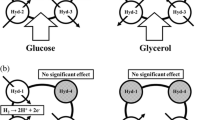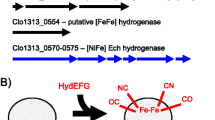Abstract
Escherichia coli has four hydrogenases (Hyd), three genes of which are encoded by the hya, hyb, and hyc operons. The proton-reducing and hydrogen-oxidizing activities of Hyd-2 (hyb) were analyzed in whole cells grown to stationary phase and cell extracts, respectively, during glycerol fermentation using novel double mutants. H2 production rate at pH 7.5 was decreased by ~3.5- and ~7-fold in hya and hyc (HDK 103) or hyb and hyc (HDK 203) operon double mutants, respectively, compared with the wild type. At pH 6.5, H2 production decreased by ~2- and ~5-fold in HDK103 and HDK203, respectively, compared with the wild type. At pH 5.5, H2 production was reduced by ~4.5-fold in the mutants compared with the wild type. The total hydrogen-oxidizing activity was shown to depend on the pH of the growth medium in agreement with previous findings and was significantly reduced in the HDK103 or HDK203 mutants. At pH 7.5, Hyd-2 activity was 0.26 U (mg protein)−1 and Hyd-1 activity was 0.1 U (mg protein)−1. As the pH of the growth medium decreased to 6.5, Hyd-2 activity was 0.16 U (mg protein)−1, and Hyd-1 was absent. Surprisingly, at pH 5.5, there was an increase in Hyd-2 activity (0.33 U mg protein)−1 but not in that of Hyd-1. These findings show a major contribution of Hyd-2 to H2 production during glycerol fermentation that resulted from altered metabolism which surprisingly influenced proton reduction.



Similar content being viewed by others
References
Khanna, S., Goyal, A., & Moholkar, V. S. (2011). Microbial conversion of glycerol: Present status and future prospects. Critical Reviews in Biotechnology, 32(3), 235–262. doi:10.3109/07388551.2011.604839. Epub Sep 27.
Trchounian, K., Poladyan, A., Vassilian, A., & Trchounian, A. (2012). Multiple and reversible hydrogenases for hydrogen production by Escherichia coli: Dependence on fermentation substrate, pH and FOF1-ATPase. Critical Reviews in Biochemistry and Molecular Biology, 47, 236–249.
Sauter, M., Bohm, R., & Bock, A. (1992). Mutational analysis of the operon (hyc) determining hydrogenase 3 formation in Escherichia coli. Molecular Microbiology, 6, 1523–1532.
Andrews, S. C., Berks, B. C., Mcclay, J., Ambler, A., Quail, M. A., Golby, P., et al. (1997). A 12-cistron Escherichia coli operon (hyf) encoding a putative proton-translocating formate hydrogenlyase system. Microbiology, 143, 3633–3647.
Self, W. T., Hasona, A., & Shanmugam, K. T. (2001). N-terminal truncations in the FhlA protein result in formate- and Moe-independent expression of the hyc (formate hydrogenlyase) operon of Escherichia coli. Microbiology, 147, 3093–3104.
Skibinski, D. A. G., Golby, P., Chang, Y.-S., Sargent, F., Hoffman, R., Harper, R., et al. (2002). Regulation of the hydrogenase-4 operon of Escherichia coli by the σ54-dependent transcriptional activators FhlA and HyfR. Journal of Bacteriology, 184, 6642–6653.
Bagramyan, K., Mnatsakanyan, N., Poladian, A., Vassilian, A., & Trchounian, A. (2002). The roles of hydrogenases 3 and 4, and the F0F1-ATPase, in H2 production by Escherichia coli at alkaline and acidic pH. FEBS Letters, 516, 172–178.
Self, W. T., Hasona, A., & Shanmugan, K. T. (2004). Expression and regulation of silent operon, hyf, coding for hydrogenase 4 isoenzyme in Escherichia coli. Journal of Bacteriology, 186, 580–587.
Maeda, T., Sanchez-Torres, V., & Wood, T. K. (2007). Escherichia coli hydrogenase 3 is a reversible enzyme possessing hydrogen uptake and synthesis activities. Applied Microbiology and Biotechnology, 76, 1036–1042.
King, P. W., & Przybyla, A. E. (1999). Response of hya expression to external pH in Escherichia coli. Journal of Bacteriology, 181, 5250–5256.
Richard, D. J., Sawers, G., Sargent, F., McWalter, L., & Boxer, D. H. (1999). Transcriptional regulation in response to oxygen and nitrate of the operons encoding the [NiFe] hydrogenases 1 and 2 of Escherichia coli. Microbiology, 145, 2903–2912.
Menon, N. K., Robbins, J., Wendt, J. C., Shanmugan, K. T., & Przybyla, A. E. (1991). Mutational analysis and characterization of the Escherichia coli hya operon, which encodes [NiFe] hydrogenase 1. Journal of Bacteriology, 173, 4851–4861.
Dubini, A., Pye, R. L., Jack, R. L., Palmer, T., & Sargent, F. (2002). How bacteria get energy from hydrogen: A genetic analysis of periplasmic hydrogen oxidation in Escherichia coli. International Journal of Hydrogen Energy, 27, 1413–1420.
Dharmadi, Y., Murarka, A., & Gonzalez, R. (2006). Anaerobic fermentation of glycerol by Escherichia coli: A new platform for metabolic engineering. Biotechnology and Bioengineering, 94, 821–829.
Murarka, A., Dharmadi, Y., Yazdani, S. S., & Gonzalez, R. (2008). Fermentative utilization of glycerol by Escherichia coli and its implications for the production of fuels and chemicals. Applied and Environmental Microbiology, 74, 1124–1135.
Trchounian, K., & Trchounian, A. (2009). Hydrogenase 2 is most and hydrogenase 1 is less responsible for H2 production by Escherichia coli under glycerol fermentation at neutral and slightly alkaline pH. International Journal of Hydrogen Energy, 34, 8839–8845.
Cintolesi, A., Comburg, J. M., Rigou, V., Zygourakis, K., & Gonzalez, R. (2011). Quantitative analysis of the fermentative metabolism of glycerol in Escherichia coli. Biotechnology and Bioengineering, 109, 187–198.
Trchounian, K., Sanchez-Torres, V., Wood, K. T., & Trchounian, A. (2011). Escherichia coli hydrogenase activity and H2 production under glycerol fermentation at a low pH. International Journal of Hydrogen Energy, 36, 4323–4331.
Trchounian, K., Pinske, C., Sawers, G., & Trchounian, A. (2012). Characterization of Escherichia coli [NiFe]-hydrogenase distribution during fermentative growth at different pHs. Cell Biochemistry and Biophysics, 62, 433–440.
Redwood, M. D., Mikheenko, I. P., Sargent, F., & Macaskie, L. E. (2008). Dissecting the roles of Escherichia coli hydrogenases in biohydrogen production. FEMS Microbiology Letters, 278, 48–55.
Jacobi, A., Rossmann, R., & Böck, A. (1992). The hyp operon gene products are required for the maturation of catalytically active hydrogenase isoenzymes in Escherichia coli. Archives of Microbiology, 158, 444–451.
Mnatsakanyan, N., Bagramyan, K., & Trchounian, A. (2004). Hydrogenase 3 but not hydrogenase 4 is major in hydrogen gas production by Escherichia coli formate hydrogenlyase at acidic pH and in the presence of external formate. Cell Biochemistry and Biophysics, 41, 357–366.
Gabrielyan, L., & Trchounian, A. (2009). Relationship between molecular hydrogen production, proton transport and the FOF1-ATPase activity in Rhodobacter sphaeroides strains from mineral springs. International Journal of Hydrogen Energy, 34, 2567–2572.
Gabrielyan, L., & Trchounian, A. (2012). Concentration dependent glycine effect on the photosynthetic growth and bio-hydrogen production by Rhodobacter sphaeroides from mineral springs. Biomass and Bioenergy, 36, 333–338.
Eltsova, Z. A., Vasilieva, L. G., & Tsygankov, A. A. (2010). Hydrogen production by recombinant strains of Rhodobacter sphaeroides using a modified photosynthetic apparatus. Applied Biochemistry and Microbiology, 46, 487–491.
Noguchi, K., Riggins, D. P., Eldahan, K. C., Kitko, R. D., & Slonczewski, J. L. (2010). Hydrogenase-3 contributes to anaerobic acid resistance of Escherichia coli. PLoS ONE, 5, 1–7.
Piskarev, I. M., Ushkanov, V. A., Aristova, N. A., Likhachev, P. P., & Myslivets, T. S. (2010). Establishment of the redox potential of water saturated with hydrogen. Biophysics, 55, 13–17.
Trchounian, K., Pinske, C., Sawers, R. G., & Trchounian, A. (2011). Dependence on the F0F1-ATP synthase for the activities of the hydrogen-oxidizing hydrogenases 1 and 2 during glucose and glycerol fermentation at high and low pH in Escherichia coli. Journal of Bioenergetics and Biomembranes, 43, 645–650.
Ballantine, S. P., & Boxer, D. H. (1986). Isolation and characterisation of a soluble active fragment of hydrogenase isoenzyme 2 from the membranes of anaerobically grown Escherichia coli. European Journal of Biochemistry, 156, 277–284.
Lukey, M. J., Parkin, A., Roessler, M. M., Murphy, B. J., Harmer, J., Palmer, T., et al. (2010). How Escherichia coli is equipped to oxidize hydrogen under different redox conditions. Journal of Biological Chemistry, 285, 3928–3938.
Soboh, B., Pinske, C., Kuhns, M., Waclawek, M., Ihling, C., Trchounian, K., et al. (2011). The respiratory molybdo-selenoprotein formate dehydrogenases of Escherichia coli have hydrogen: Benzyl viologen oxidoreductase activity. BMC Microbiology, 11, 173.
Zbell, A. L., & Maier, R. J. (2009). Role of the Hya hydrogenase in recycling of anaerobically produced H2 in Salmonella enterica serovar typhimurium. Applied and Environmental Microbiology, 75, 1456–1459.
Acknowledgments
The study was supported by the FEBS Summer Research Fellowship to KT (2010), by the Deutsche Forschungsgemeinschaft (Grant SA 494/3-1 to RGS), and by the Ministry of Education and Science of Armenia (Research Grant #11-F202 to AT).
Author information
Authors and Affiliations
Corresponding author
Rights and permissions
About this article
Cite this article
Trchounian, K., Soboh, B., Sawers, R.G. et al. Contribution of Hydrogenase 2 to Stationary Phase H2 Production by Escherichia coli During Fermentation of Glycerol. Cell Biochem Biophys 66, 103–108 (2013). https://doi.org/10.1007/s12013-012-9458-7
Published:
Issue Date:
DOI: https://doi.org/10.1007/s12013-012-9458-7




